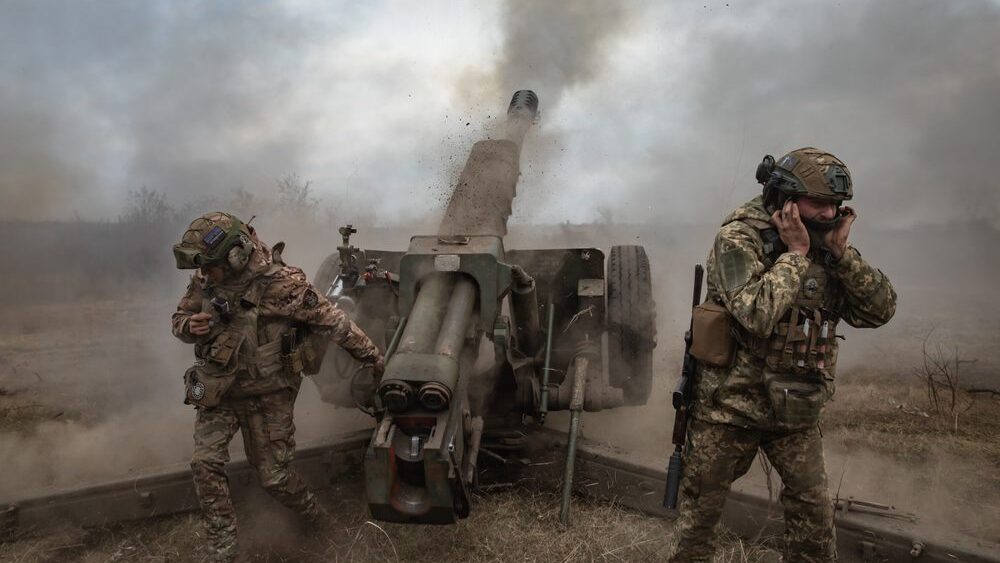
Artillerymen from the Ukrainian armed forces shooting from 122mm Howitzer D-30 near Bakhmut,
Photo: Drop of Light / Shutterstock.com
“We are a large enough, big enough, economically viable and vibrant enough country to be able to support both,” John Kirby, a spokesman for the National Security Council in the White House said on Monday, October 9th, as questions begin to arise about whether the United States is capable of aiding both Ukraine and Israel militarily.
The White House confirmed on Monday, October 9th, that the U.S. has already begun delivering ammunition and military equipment to Israel, which came under attack from the Palestinian terrorist group Hamas on Saturday. As The New York Times points out, the United States already provides Israel with more than $3 billion in military assistance every year, and the Pentagon also has stockpiles of arms and ammunition worth about $2 billion at about six sites throughout Israel. The stockpiles provide weapons and ammunition for the Pentagon to use in Middle East conflicts, but the U.S. has also allowed Israel access to the supplies in emergencies.
Additionally, Defence Secretary Lloyd Austin ordered the USS Gerald R. Ford aircraft carrier, accompanied by cruisers and destroyers, to sail to the Eastern Mediterranean to be ready to assist Israel and to deter Iran or Iranian-backed groups, like Hezbollah, from escalating the conflict.
NEWS: U.S. Helps Israel Defend Against Hamas Attacks https://t.co/XqaTDFGxJn
— Department of Defense 🇺🇸 (@DeptofDefense) October 10, 2023
Another drawn-out war—like the one in Ukraine which has been raging on since the invasion by Russia almost twenty months ago—would heavily burden the arms industry in the United States as Washington seeks to assist its allies. But the wars are especially worrisome for Europe, which is running short on ammunition and does not have the capacity to help Israel.
“We face a huge ammo shortage due to Ukraine,” a German official told U.S. publication Foreign Policy, with many other European officials fearing their governments have exhausted their resources.
Admiral Rob Bauer, who chairs the NATO Military Committee, warned last week that European ammunition stocks are running short. “We now give away weapons systems to Ukraine, which is great, and ammunition—but not from full warehouses. We started to give away from half full or lower warehouses in Europe. And therefore, the bottom of the barrel is now visible,” he told delegates at the Warsaw Security Forum.
One major concern, according to Reuters, has been a shortage of 155mm artillery rounds, with Kyiv firing up to 10,000 of these shells per day. Much of the ammunition is supplied by Kyiv’s Western allies. Ukrainian President Volodymyr Zelensky warned of shortages that are causing difficulties in the Ukrainian counteroffensive against Russia. “Difficulties are posed by the minefields and by the shortages of weapons and ammunition, especially air defenses,” he said last week.
The European Union, the UK, and the United States have all outlined plans to ramp up weapons production.
The Pentagon said in July it had provided Ukraine with more than 2 million artillery rounds to date. “We’ve seen large amounts of artillery be employed on both sides of the fence. And so that puts a strain on the international supply of munitions, artillery munitions,” Defence Secretary Lloyd Austin said at the time. The Pentagon, with Israel’s permission, has had to use some of its stockpile in Israel to help meet Ukraine’s need for artillery shells. If the fighting in the Middle East widens, the amount of supplies in the stockpiles could become an issue, analysts told The New York Times.
Between Saturday and Monday morning, over 1,200 targets were hit by Israeli aircraft across the Gaza Strip, including weapons storage and manufacturing sites, command and control centers, rocket launchers and more.
— Israel Defense Forces (@IDF) October 9, 2023
Today we doubled that number. pic.twitter.com/bRxZetbNqP
To complicate matters, the Pentagon needs the approval of Congress to fulfill Israel’s request for more Iron Dome missile interceptors, ammunition, and smalldiameter bombs, but the House of Representatives is without a permanent speaker and the Senate is out of Washington until next week. Army Secretary Christine Wormuth said Congress must pass more funding quickly for the U.S. to be able to give both Israel and Ukraine the weapons and munitions they both now need. While both Republican and Democratic lawmakers expressed support for Israel, the funding of Ukraine’s war with Russia is facing obstacles, with a large portion of Republicans opposing any new aid.
